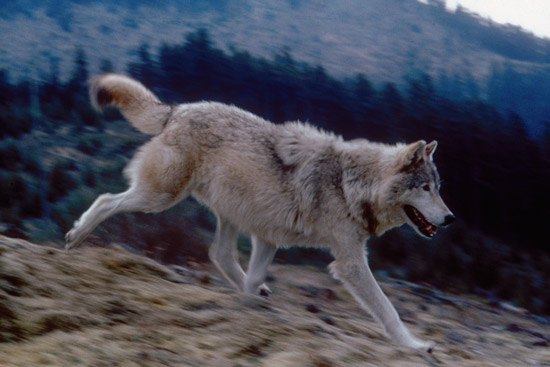Wolves in Idaho
Reports and Plans
- 2016 Idaho Wolf Management Report
– January 1, 2016 - June 30, 2017 [PDF, 1.6 MB] - Wolf Conservation and Management Plan
– [PDF, 662 KB] - Idaho Gray Wolf Management Plan 2023-2028
– [PDF, 3.6 MB]
Links and Information
- Report Wolf Sightings Here
- U.S. Fish & Wildlife Service Wolf Website - Federal news, information & recovery status.
Management
- Understanding Predation Management in Idaho
– [PDF, 385 KB] - Wolf Management Background
- Wolf Management Timeline
Livestock Conflicts
On May 5, 2011, wolves in Idaho were removed from the list of endangered species, and management reverted to the state under state code 36-1107, and guided by Idaho's 2002 Wolf Conservation and Management Plan. [pdf, 662 kb]
Livestock and domestic animal owners may take nonlethal steps they deem necessary to protect their property. The Utah State University Extension’s brochure Lines of Defense: Coping with Predators in the Rocky Mountain Region [pdf file] provides a great resource for nonlethal management options.
A permit must be obtained from the director to control (remove) wolves not molesting or attacking livestock or domestic animals. Control is also permitted by owners, their employees and agents pursuant to the Idaho Department of Fish and Game harvest rules.
Idaho Code states that wolves molesting or attacking livestock or domestic animals may be controlled (killed) by livestock or domestic animal owners, their employees, agents and animal damage control personnel. No permit from Fish and Game is necessary. The incident must be reported to the Fish and Game director within 72 hours (although additional time may be allowed if access to the site where taken is limited). Wolves taken in this manner remain the property of the state.
To report suspected wolf depredations on livestock or pets, contact: USDA Wildlife Services, toll-free: 866-487-3297 or 208-373-1630
Hunting - Trapping
- Visit the Big Game Seasons and Rules for current wolf hunting and trapping laws and details.
- Wolf Trapper Education Course
- Wolf Harvest Quotas
Disease
- Echinococcus granulosus - Wolves and other canids are known carriers of a parasitic tapeworm that is linked to hydatid disease in humans. Hunters are encouraged to wear rubber gloves when skinning canids and to avoid handling canid feces.

Wolves in the Wild
Wolves are highly social animals, and the family structure is focused around the pack. Packs typically consist of a breeding pair—the “alpha male and alpha female”—and their young from previous years. Pack size doesn't vary much between years because the wolves that either leave or die each year are replaced by newborn pups.
Wolves breed in late winter, and give birth to an average of four to five pups in April. The pups are born in a den dug by the breeding female, around which the pack congregates. Wolf pups spend their first six to eight weeks at the den, and are weaned at around six weeks of age. Once they begin eating meat, the pups are fed by adult members of the pack.
As the pups become older the pack typically moves them from the den to “rendezvous sites”, which are usually wet meadow areas within a pack’s territory where the adults can leave the pups while they go off to hunt. Wolves may use several rendezvous sites during the summer months until the pups are big and strong enough to travel full-time with the pack, generally by late September or October.
An adult male wolf stands about 30 inches at the shoulder and can be over six feet long from the tip of nose to point of tail. It will weigh 70 to 110 pounds. Females are slightly smaller, usually 60 to 80 pounds.
